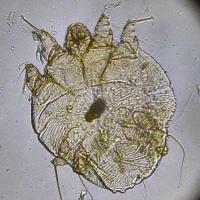Black Bear Mange
What causes mange?
Mange is a contagious skin disease of many wild and domestic mammals that is caused by microscopic mites that burrow into the skin. A mange infection can only be confirmed by taking a skin scrape from a bear and looking for the mite under a microscope.
Do bears in North Carolina have mange?

Black bears can be affected by several types of mange, including Uriscoptic, Demodectic, and Sarcoptic mange, which are each caused by different species of mites.
Sarcoptic mange (caused by the mite Sarcoptes scabiei) is the most common in wildlife, such as red foxes, but has not yet been detected in black bears in North Carolina. The N.C. Wildlife Resources Commission (NCWRC) has confirmed Uriscoptic mange in a few bears, but this type of mange does not typically result in the severe hair loss that we see with Sarcoptic mange. Sarcoptic mange in black bears is of significant concern due to expansion of the Sarcoptes scabiei mite in black bears in neighboring states and can be a cause of mortality in some bears.
There are many unknowns relating to the spread and maintenance of mange in bears. Mites can be transmitted when the infected host comes into direct physical contact with a new host. Additionally, mites can fall off an infected host and survive in the environment until a new animal comes into contact with that environment.
Existing research on Sarcoptes scabiei indicates that the mites can survive outside of a host from a few days to a few weeks, depending on environmental conditions (such as temperature and humidity).
Because bears are relatively solitary, the largest risk for infection occurs under conditions when bears congregate together, either naturally (e.g. dens) or unnaturally (e.g. bait piles, trash cans, bird feeders).
What are the clinical signs of mange in bears?
The clinical signs of mange are the results of damage to the host’s skin by the burrowing mite and the immune reaction of the host’s body to the mite. Clinical symptoms include:
- Intense itching or rubbing
- Hair loss
- Thickened and dry skin, sometimes covered with scabs or tan crusts
- Weight loss
- Altered behavior including lethargy, lack of awareness, or lack of concern with surroundings
The extent of these clinical signs varies from hairless areas on the ears and face or small patches along the body in mild to moderate cases, to hair loss and lesions covering almost the entire body in severe cases. Severely affected bears are typically emaciated, lethargic, and are often found wandering apparently unaware of their surroundings.

Human and domestic animal health risks
Transmission of mange-causing mites to humans and pets is rare and only documented with Sarcoptic mites. Transfer occurs through prolonged physical contact with infested animals or environments that contain those mites. Infestations in humans typically appear as a rash which resolves by itself, often without medical intervention. In pets, mange infections can become severe, but the condition is treatable with medication. Consult your doctor or pet’s veterinarian for more information.
What is the North Carolina Wildlife Resources Commission doing?
The NCWRC is actively monitoring for the presence of mange mites in our black bear populations and is recording all reports received by the public to better manage bear populations and minimize disease transmission. Unless the animal is in distress or exhibiting other symptoms of disease, the NCWRC does not typically take any action towards animals exhibiting mange or hair loss.
The NCWRC is opportunistically sampling black bears and sending these samples to the Southeastern Cooperative Wildlife Disease Study for analysis. You can view reports of confirmed mange in the eastern US by visiting this website.
What can you do to help?
The most important thing you can do to reduce the spread of mange is discontinuing the feeding of birds and other wildlife. Feeding concentrates animals and can lead to disease outbreaks. Secure or remove bird feeders, animal feed, trash, and pet food from your property. Feeding of pets and other animals outdoors should be stopped if there is evidence that bears are being attracted to the area.
People should not attempt to medically treat any animals, including bears, that they believe have mange. The treatment of mange requires multiple precise doses of anti-parasite medication, which should be performed under the supervision of a veterinarian and is impractical to implement on free-ranging animals. Additionally, recent research has shown black bears are naturally resilient to mange and often resolve mange infections over time without intervention. Recovery rates of affected black bears are similar among treated and untreated individuals.
If you see a bear or any animal with mange, please contact the Wildlife Helpline at wildlifehelpline@ncwildlife.gov or by calling (866) 318-2401.
